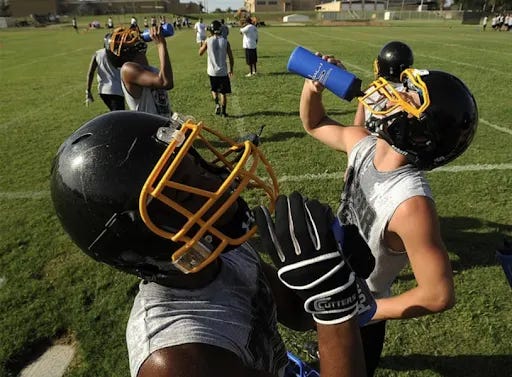Beat the heat: Tips for coaches, parents, and players
As summer workouts kick off across Arkansas following the AAA Dead Period the risks associated with extreme heat rise as temps get higher each week. For the past 14 years, ArkansasVarsity.com has published an annual awareness article to help players, coaches, and parents recognize and prevent heat-related injuries—and that message is as vital as ever.
With team activities resuming soon it is crucial to revisit safety practices designed to protect athletes from the dangers of heat exposure. Certified athletic trainers B.J. Maack and Jason Cates continue to be strong advocates for proactive safety and education.
“Every school needs to look into having a certified athletic trainer,” said Maack. “Heat injuries are the third most common type of athletic injury, but they’re the only one that is 100 percent preventable.”
Maack emphasized that athletic trainers are specially trained to identify issues that may go unnoticed by coaches. While hydration is a key component, he and Cates agree that comprehensive heat safety includes far more than just drinking water.
Key Recommendations from Maack and Cates:
For Coaches and Staff:
Monitor the Weather: Use heat index charts to track both temperature and humidity. Know when to remove pads or cancel practice altogether.
Self-Awareness: Coaches must be in top shape themselves to stay alert to their athletes' needs.
Have an Athletic Trainer: If not possible, designate a staff member responsible for health and hydration monitoring.
Structured Breaks: Take breaks every 20 minutes during intense summer heat. Let players remove helmets and pads and cool off in shaded areas.
Watch for Dehydration Symptoms: Monitor urine color. Light to dark yellow indicates dehydration. Hold out players with very dark urine until they’re rehydrated.
Track Weight Loss: Weigh athletes before and after practice. Losing more than 5% of body weight puts them at high risk. Replace each pound lost with at least 20 ounces of fluids within two hours.
Identify Heavy Sweaters: Athletes with excessive sweat or salt rings on clothes are at higher risk for cramping and heat illness. Encourage increased fluid and salt intake—pickle juice, mustard, and salt tablets remain useful.
Don’t Forget Officials: Referees are also susceptible. Prepare hydration plans for them as well.
For Parents and Athletes:
Understand the Risk: Heat-related illness can be life-threatening. Take it seriously.
Address Stress: Emotional or mental stress can amplify physical exhaustion. Communicate and support your athlete.
Balanced Nutrition: Encourage nutritious meals before and after practice. Fruits are ideal due to their natural sugars and hydration properties.
Avoid Overtraining: Don’t engage in extra activities like weightlifting or swimming after practice, as they can lead to overexertion.
Healthy Sleep Habits: Athletes should be in bed by 9 PM and wake early enough to eat a full, balanced breakfast.
Hydration Is Constant: Drink throughout the day—not just during workouts. Never pass a water fountain without drinking.
Follow a Hydration Plan:
17–20 oz at home before leaving
7–10 oz on the way to practice
28–40 oz during workouts
20 oz per pound of weight lost post-workout
Listen to Your Body: Athletes should report dizziness, nausea, or trouble focusing. These are early signs of heat illness—not excuses.
No Retaliation: Players should never be punished for requesting a hydration break. Everyone handles heat differently.
Nutrition & Recovery:
Both Maack and Cates stress that food plays an equal role in safety and performance.
“Hydration is great, but you must eat right, too,” said Maack.
“Fruits are great sources of energy and hydration,” added Cates. “Carbohydrates are key for athletes because they fuel and support muscle performance.”
Meals should be high in carbs, moderate in fiber, and low in fat. Maack also noted that low-fat chocolate milk has been shown to outperform sports drinks like Gatorade as a recovery beverage due to its ideal carb-to-protein ratio.
Looking Ahead: Changing Conditions Require New Solutions
Cates also shared that the Arkansas Athletic Trainers Association is working with the Arkansas Activities Association on new safety protocols.
“The O-Zone levels are a factor now. That wasn’t something we talked about 20 years ago,” said Cates. “Times have changed, and the rules will have to as well.”
Increased media and parental concerns have prompted discussions about adapting the state’s approach to summer training—acknowledging that simply canceling football is unlikely.



